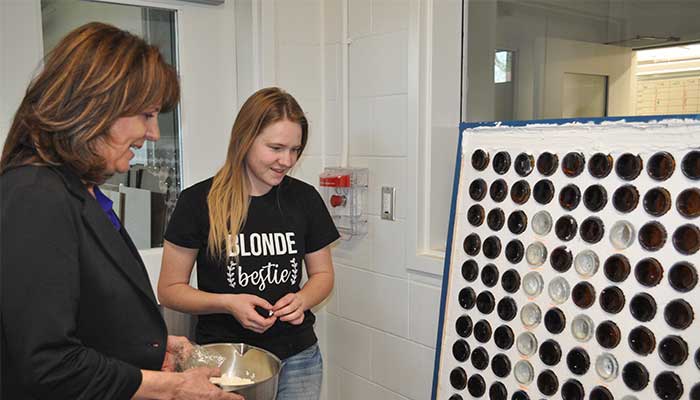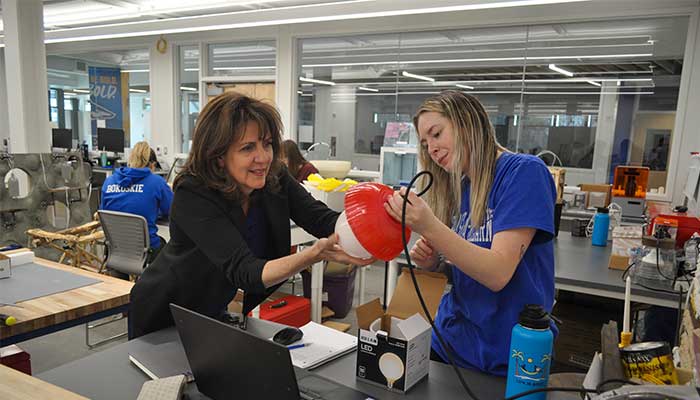Dana Vaux, How an Emerging Thought Leader Shapes the Teacher-Scholar Model at UNK
Posted: November 8, 2022 12:00:00 AM CST
Decorating and home shows may have us thinking that interior design is about choosing shower tile, paint colors, and deciding whether to “open up” the floorplan. But to Dana Vaux, University of Nebraska at Kearney’s Interior and Product Design Associate Professor, design is so much more. “When I taught the introductory class, I started out with ‘what is interior design?’ It’s not what we see on HGTV. It’s very much a technical skill.” For Vaux, it’s also about research and helping people understand “how much the physical environment impacts our psychological, emotional, and relational well-being. “
Curiosity Drives Research
Vaux, whose whole body lights up when talking about interior design, teaching, and research, explains there are two types of research in her field. Design research, which is “researching for a specific context or space” and research for design which “starts out with something very general and applies it to a targeted context, or multiple scenarios.” For example, if research was being done for a Kindergarten and an outdoor space, “the first might ask, what is the best use of indoor-outdoor space for this classroom?” The second would ask “what’s the impact of having outdoor spaces for 5-year-olds?”
Vaux enjoys research for design and weaves this type of research into her Interior and Product Design classes at UNK. Freshman research coffee shops “to start to understand how the physical environments and humans interact” whereas seniors in her research methods class choose a topic, such as lighting or children with autism, to “begin to understand how to design or make an environment more accessible for humans.”
Learning Improves Teaching
Vaux, whose decorating style leans towards eclectic, sees research as “almost like self-learning. You could read in a book that people like to sit by windows, but when you see it and make that connection, and go ah-ha, it can now be applied to multiple settings.”
Researchers are curious, ask questions, solve problems, and are open to learning. Vaux does all three. This makes her a great example of the teacher-scholar model at UNK, that highlights the cyclical education process. It’s where teachers are also researchers and “bring things back to the classroom that informs their teaching and impacts your students, one graduating class at a time, which further impacts the field and your research.” A teacher’s research brings value, but as Dana explains, “that’s not the end goal. The end goal is for it to come back and impact your teaching and then your students. That’s the multiplier.”
But it’s not only the students who are learning from their teacher. Vaux, who has been teaching at UNK for the last 8 years, also learns from her students. It’s one thing she loves about teaching. “I’m always learning from my students. They bring me things I haven’t thought about or together we think about things in new ways, and that’s really exciting.”
Solving Problems Leads to New Products
While teaching her first research methods class, Vaux discovered there was no “book targeted for interior design research that was accessible to early master’s students or undergraduate students.” She solved this problem by designing her own curriculum, “pulled from different resources.” She then teamed up with David Wang, her former architect professor who taught her research class at Washington State University, to co-author and edit Research Methods for Interior Design: Applying Interiority. “I guess my primary motivation wasn’t just that nothing met my own need. But, if we want interior designers to understand more about the environment they build and how humans are impacted, we need to teach research.”
Also, her forthcoming book, Practical Ethics in Architecture and Interior Design Practice, available for spring semester 2023, is another groundbreaking book in her field. Dana co-authored it with David Wang and architect, Sue Lani Madsen, a colleague Wang taught with. Wang and Madsen were using an ethics textbook from 2000 and wanted to write an up-to-date book for undergraduates that included both architecture and interior design. When they approached Vaux with the book concept, she “liked the idea of having a book that centered on practice content, but also talked about ethics. These are the kinds of issues a student wrestles with once they get into practice.” Each chapter starts with a fictional practice scenario that deals with real life issues. Some things are “right or wrong, legal or illegal. But ethics is the weighing of what’s the best decision for the scenario that’s good for all the stakeholders.”
Last spring, Vaux gave the book content a test run in her class. “It was fun. Having the scenarios made it easy to talk about the professional practice.” Students sometimes “chose a different character and defend that character’s position.” Vaux says she’s most excited about the book because “it’s ethics, but within the context of practice issues, which helps students succeed. They understand better how the business world works.”
Asking Questions Drives the Future
Between her hobbies of writing, flowers, bicycling, and swimming, Vaux has won several faculty awards at UNK. Last year, her and a colleague won an award for research into how the idea of virtual space impacts “student attachment in the virtual classroom and their connectedness in terms of a sense community and collaboration.” She is also the Editor-in-Chief of IDEC Exchange, a biannual publication and organization of interior design educators. “It gives us opportunities to share what’s going on in our classrooms and in our research related to a current topic.”
When asked about her next book, Vaux who at the time of this interview was in the middle of editing and getting the book off to the publisher, said, “There definitely needs to be something for interior design theory for undergraduates, but I don’t have any plans.”
If the past years and projects are any indication, Vaux will soon be involved in another project – one that combines her excitement about teaching, interior design, and research. While she can tell you why we are more attached to one space over another or why building codes are important, she always circles back to people. “I love interior design because while it is about the physical environment, it’s ultimately really about people.”









